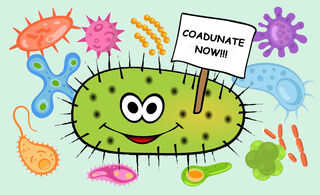Environment
How Evolution Can Help Us: The R0 of a Conspiracy Theory
Part 2: The mechanisms of microbial evolution can help explain recent events.
Posted February 18, 2021

The R0 of a Conspiracy Theory
First, what is R0? Pronounced “R naught,” it’s a mathematical term that indicates how contagious an infectious disease is. Also known as the reproduction number.
It’s occurred to me that conspiracy theories are essentially viruses of thought, and likewise have outbreaks, epidemics, and pandemics. I first ran into R0 and conspiracy theories several years ago, when I was engaged as a strategic consultant by UNICEF’s Global Polio Eradication Initiative. My team was tasked to help find ways to address a massive polio outbreak in the Middle East and Eastern Africa. It wasn’t a project that most strategic consultants wanted, as it required travel to places like Somalia and Pakistan, where K&R insurance is required.
The most interesting thing that I learned was that the eradication of polio was made much more difficult by the weaponization of conspiracy theories by Islamist extremists. These conspiracy theories were endemic to the society in which they emerge, so one popular conspiracy theory was that the vaccine was not halal. UNICEF went to great lengths to set up a halal vaccine production facility in the Philippines, and had a number of clerics visit and bless the facility. The intervention was to show videos of trusted clerics attesting that the vaccine was halal. Another—my favorite—was one that was impossible to disprove, that “George Bush urinated in the vaccine culture.” How can you possibly disprove, or prove, something like this?
But the most pernicious conspiracy theory was that the polio vaccine was a Western plot to sterilize children—this was intentionally launched by a group of Nigerian religious leaders. However, when they later tried to repudiate their own statements to restart the vaccination programs, to save their own children, they couldn’t. The true believers simply assumed that these leaders had been corrupted by the West, as the theory took on a life of its own. Something similar is happening in the West, where specific psychosocial triggers attach to our psyches like the coronavirus’s spike protein that attaches to an ACE2 receptor.
When my team interviewed people in the slums of Rawalpindi, and in train stations in small Pakistani towns—with a police escort—we heard many of these conspiracy theories, cataloging them like a rare species. These conspiracy theories are similar to the rumor that opals are unlucky—virtually impossible to stop. For the polio eradication project, these rumors presented “perceptional challenges” that could only be addressed through an intensive advocacy strategy.
The greatest lesson I learned about how people deal with conspiracy theories came about when I interviewed a grandmother shepherding her grandchildren through a bustling train station in central Pakistan. After respectfully greeting her with a proper salam, I asked her about whether her grandchildren had received the vaccine, and when she said no, I promised her I wouldn’t harangue her. I just pleaded to understand her thinking process. She was happy to have someone listen to her burdens, and explained to me that her husband—the patriarch of the family—was swayed by radicalized clerics, and demanded that all the children refuse the vaccine. But at the same time, her son was a doctor in Karachi and begged her to have all the grandchildren quietly inoculated anyway. She explained that she was in a difficult situation—on one hand, her husband was clearly too angry at the West to think rationally, but on the other, she couldn’t defy her husband. And then again, her son was a doctor and she knew he could be trusted to have the family’s best interest at heart.
“So what did you do?” I asked. She answered blithely, “I let half my children get the vaccine.”
Wow, a decision worthy of Solomon. I did have to respect her ingenuity in threading the needle. What I realized from this ethnographic interview was that the deciding factor wasn’t the billion dollars UNICEF had spent on advertising. The difference was her son. Her son advocated the use of the vaccine, and she trusted her son.
There is no vaccine for a conspiracy theory.
You can’t inject a syringe of truth and advertise the conspiracy theory away. Passing laws and fining people who spread conspiracy theories won’t work either.
I believe that the only thing that will really work is to create an intensive global advocacy program, powered by tens of thousands of trained advocates—ideally with medical training—to counter the weaponization of anti-vax conspiracy theory through bots and social media. A friend in the counter-terrorism business had this great line: “It takes a network to break a network.”
This global advocacy network could crowdsense new conspiracy theories, and their variants, to provide early detection and interventions. These advocates need to be armed with debunking content that is emotionally evocative. This is known as “prebunking.” And we need to do this now. Why? Because the challenge for America is that if too many people are vaccine-hesitant, viral variants will “escape” the vaccines, with the end result of multiplying the global death rate. This is why there is a goal of vaccinating 100 million people in 100 days.

Let me say this as clearly as I can: Vaccines work and are extremely safe. Think about smallpox: if scientists had not developed that vaccine, reasonable estimates are that between 1980 and 2018 somewhere around 150 to 200 million lives have been saved. However, these advocates also need to tell the truth about the risks of the new vaccines. We need to admit that it’s riskier but nowhere near as risky as the one in a thousand chance of dying from COVID. What we should do is promote the idea that timely vaccination is an act of courage and service to humanity. If you want to build a better world, roll up your sleeve.
The Biggest Lesson of Multi-Cellularity
If we go back to the analogy of multi-cellular coadunation from Part 1 of this series, a multicellular organism can survive if a small percentage of its cells refuse to cooperate. But if 20 percent of the cells refuse to agree on what is reality, the organism will fall apart like an eukaryotic slime mold disintegrating. That is the challenge the human race faces right now.
Therefore, the most important goal for humanity should be to improve the capacity to see and agree on reality together—what I call “trust-intrinsic community perception.” For example, research into how people are radicalized via conspiracy theories has shown that 80 percent of the time, it’s because Facebook recommended these extremist views to them. Facebook's algorithms are tuned to make money, so they are relatively easy for conspiracy theorists and extremists to leverage. Just ask Cambridge Analytica how easy. Fixing Facebook would be a good intervention but by no means the only one that’s needed to fix our society.
And we need to get there faster. This is because SARS-CoV-2 is only a practice drill for what’s coming. The next thing to worry about is Disease X. According to virologists, there are anywhere between 631,000 and 827,000 viruses that have the ability to infect people. Scientists currently know of only 263 viruses that can infect people, which means that we know almost nothing about 1.67 million unknown viruses out there. The World Health Organization warns that Disease X will make COVID look like a picnic. Instead of 2 million dead, it’ll be more like 50-100 million.
But an even greater threat humanity faces is anthropogenic global warming. Climate change has already begun to kill. It is proposed that the carbon budget for 2°C anthropogenic global warming (roughly 1012 tons of carbon) will indirectly cause roughly one billion premature deaths. And what we’ve seen is the same kind of thing we faced with COVID—it’s a hoax, you can’t believe the scientists, etc. More lies from people with a vested interest. But it may be that COVID’s silver lining is that it gave humanity a wake-up call, teaching our species how to deal with emerging threats that will cost a hundred times more lives. And it all begins with focusing on the act of learning how to see and agree on reality, together.
Follow this link to read Part 1 of this series.




